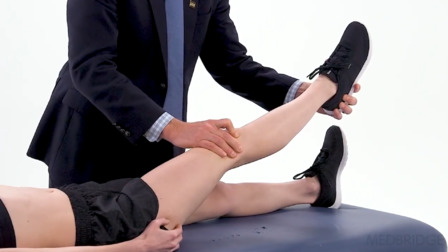Evidence-Based Treatment of the SIJ/Pelvis
Presented by Alexis Wright
12-Month Subscription
Unlimited access to:
- Thousands of CE Courses
- Patient Education
- Home Exercise Program
- And more
In this course, learners will experience the recommended evidence-based interventions for the sacroiliac joint and pelvis. Users will recognize the more prevalent SIJ/pelvis pathologies seen in musculoskeletal practice and understand the proposed benefit to classifying SIJ/pelvis conditions through use of the Pain and Disability Drivers Management model. Techniques used to target the primary impairment are explained, as well as the adjunctive techniques used to target the primary impairment and secondary contributors, and the techniques used to target global conditional issues. Learners will analyze the effectiveness of each technique for treatment within the classifications. Throughout the course, current research is presented to provide learners with the proper tools for evidence-based management of these patients. This course is part of a comprehensive clinical series covering examination and intervention for the cervical, thoracic, and lumbar spine, as well as the upper (shoulder, elbow, wrist, and hand) and lower (hip, pelvis, knee, foot, and ankle) quarters.
Meet your instructor

Alexis Wright
Alexis A. Wright serves as professor and program director for the Tufts DPT Boston program. Wright has been invested in DPT education since 2011. She was recognized as a fellow of the American Academy of Orthopaedic Manual Physical Therapists in 2011 and achieved APTA board-certified orthopedic specialization in 2015. Wright…
Chapters & learning objectives

1. Common Pathologies of the SIJ/Pelvis
In this chapter, learners will recognize the more prevalent SIJ/pelvic pathologies seen in musculoskeletal practice. One of the key goals is geared toward understanding the etiology behind each of the pathologies and the prognosis of each.

2. Pain and Disability Drivers of the SIJ/Pelvis
The primary pain and disability drivers for the SIJ/pelvis include: (1) nociceptive pain elements, (2) neuropathic pain elements, (3) comorbidity pain and disability elements, (4) mood and cognitive pain and disability elements, and (5) social and environmental disability elements. Each of the domains that is specific to the SIJ/pelvis is discussed.

3. Interventions Directed at Impairments Specific to the Involved Joint
This chapter reviews the techniques used to target pain relief or strength specifically toward the targeted region that is impaired within the SIJ/pelvis. The chapter will analyze the effectiveness of each technique for treatment within the local impairment classification.

4. Regional Interventions Directed at Structures That Mediate the Impaired Level
In this chapter, learners will review the adjunctive techniques used to target the primary impairment and secondary contributors. Learners will analyze the effectiveness of each technique for treatment within the regional designation.

5. Global-Body or Whole-Person-Directed Interventions
Within this chapter, the focus is less on the impairment and more on motor control, proprioception, cognitions, behaviors, and whole-body conditioning. Learners will review techniques associated with lifestyle medicine, global management, and cognitive-behavioral approaches.

6. Case Study: Pelvic Girdle Pain Syndrome
This chapter, will review the clinical case that is designed to illustrate a unique teaching point.
More courses in this series

Crucial Factors Influencing Health & Recovery in Musculoskeletal Care
Chad Cook

Evidence-Based Examination of the Cervical Spine: An Update
Chad Cook

Evidence-Based Treatment of the Cervical Spine: An Update
Chad Cook

Cervical Spine Examination and Treatment: Cases to Synthesize Learning
Chad Cook

Evidence-Based Examination of the Thoracic Spine: An Update
Chad Cook

Evidence-Based Treatment of the Thoracic Spine: An Update
Chad Cook

Thoracic Spine Examination and Treatment: Cases to Synthesize Learning
Chad Cook

Evidence-Based Examination of the Lumbar Spine: An Update
Chad Cook

Evidence-Based Treatment of the Lumbar Spine: An Update
Chad Cook

Lumbar Spine Examination and Treatment: Cases to Synthesize Learning
Chad Cook

Evidence-Based Examination of the Elbow, Wrist, and Hand: An Update
Chad Cook

Evidence-Based Treatment of the Elbow, Wrist, and Hand: An Update
Chad Cook

Elbow, Wrist, and Hand Examination and Treatment: Cases to Synthesize Learning
Chad Cook

A Primer on Exercise and Treatment Prescription
Alexis Wright

Evidence-Based Examination of the Hip: An Update
Alexis Wright

Evidence-Based Treatment of the Hip: An Update
Alexis Wright

Hip Examination and Treatment: Cases to Synthesize Learning
Alexis Wright

Evidence-Based Examination of the Foot and Ankle: An Update
Alexis Wright

Evidence-Based Treatment of the Foot and Ankle: An Update
Alexis Wright

Foot and Ankle Examination and Treatment: Cases to Synthesize Learning
Alexis Wright

Evidence-Based Examination of the SIJ/Pelvis
Alexis Wright

Evidence-Based Treatment of the SIJ/Pelvis
Alexis Wright

A Primer on Examination and Treatment Metrics
Eric Hegedus

Evidence-Based Examination of the Shoulder: An Update
Eric Hegedus

Special Tests of the Shoulder
Eric Hegedus

Evidence-Based Treatment of the Shoulder: An Update
Eric Hegedus

Management of the Shoulder: Case-Based Vignettes
Eric Hegedus

Evidence-Based Examination of the Knee and Thigh: An Update
Eric Hegedus

Special Tests of the Knee
Eric Hegedus

Evidence-Based Treatment of the Knee and Thigh: An Update
Eric Hegedus

Management of the Knee and Thigh: Case-Based Vignettes
Eric Hegedus